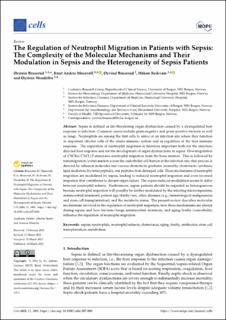| dc.contributor.author | Bruserud, Øystein | |
| dc.contributor.author | Mosevoll, Knut Anders | |
| dc.contributor.author | Bruserud, Øyvind | |
| dc.contributor.author | Reikvam, Håkon | |
| dc.contributor.author | Wendelbo, Øystein | |
| dc.date.accessioned | 2024-01-04T12:28:49Z | |
| dc.date.available | 2024-01-04T12:28:49Z | |
| dc.date.created | 2023-05-11T09:40:32Z | |
| dc.date.issued | 2023 | |
| dc.identifier.citation | Cells. 2023, 12 (7), Article number:1003, 1-43 | en_US |
| dc.identifier.issn | 2073-4409 | |
| dc.identifier.uri | https://hdl.handle.net/11250/3109843 | |
| dc.description | This article is an open access article distributed under the terms and conditions of the Creative Commons Attribution (CC BY) license (https:// creativecommons.org/licenses/by/ 4.0/). | en_US |
| dc.description.abstract | Sepsis is defined as life-threatening organ dysfunction caused by a dysregulated host response to infection. Common causes include gram-negative and gram-positive bacteria as well as fungi. Neutrophils are among the first cells to arrive at an infection site where they function as important effector cells of the innate immune system and as regulators of the host immune response. The regulation of neutrophil migration is therefore important both for the infection directed host response and for the development of organ dysfunctions in sepsis. Downregulation of CXCR4/CXCL12 stimulates neutrophil migration from the bone marrow. This is followed by transmigration/extravasation across the endothelial cell barrier at the infection site; this process is directed by adhesion molecules and various chemotactic gradients created by chemotactic cytokines, lipid mediators, bacterial peptides, and peptides from damaged cells. These mechanisms of neutrophil migration are modulated by sepsis, leading to reduced neutrophil migration and even reversed migration that contributes to distant organ failure. The sepsis-induced modulation seems to differ between neutrophil subsets. Furthermore, sepsis patients should be regarded as heterogeneous because neutrophil migration will possibly be further modulated by the infecting microorganisms, antimicrobial treatment, patient age/frailty/sex, other diseases (e.g., hematological malignancies and stem cell transplantation), and the metabolic status. The present review describes molecular mechanisms involved in the regulation of neutrophil migration; how these mechanisms are altered during sepsis; and how bacteria/fungi, antimicrobial treatment, and aging/frailty/comorbidity influence the regulation of neutrophil migration. | en_US |
| dc.language.iso | eng | en_US |
| dc.publisher | MDPI | en_US |
| dc.rights | Navngivelse 4.0 Internasjonal | * |
| dc.rights.uri | http://creativecommons.org/licenses/by/4.0/deed.no | * |
| dc.subject | metabolism | en_US |
| dc.subject | stem cell transplantation | en_US |
| dc.subject | antibiotics | en_US |
| dc.subject | frailty | en_US |
| dc.subject | aging | en_US |
| dc.subject | chemotaxis | en_US |
| dc.subject | neutrophil subsets | en_US |
| dc.subject | neutrophils | en_US |
| dc.subject | sepsis | en_US |
| dc.title | The regulation of neutrophil migration in patients with Sepsis: The complexity of the molecular mechanisms and their modulation in Sepsis and the heterogeneity of sepsis patients | en_US |
| dc.type | Peer reviewed | en_US |
| dc.type | Journal article | en_US |
| dc.description.version | publishedVersion | en_US |
| dc.rights.holder | © 2023 by the authors. Licensee MDPI, Basel, Switzerland. | en_US |
| dc.source.pagenumber | 1-43 | en_US |
| dc.source.volume | 12 | en_US |
| dc.source.journal | Cells | en_US |
| dc.source.issue | 7 | en_US |
| dc.identifier.doi | 10.3390/cells12071003 | |
| dc.identifier.cristin | 2146863 | |
| dc.source.articlenumber | 1003 | en_US |
| cristin.ispublished | true | |
| cristin.fulltext | original | |
| cristin.qualitycode | 1 | |

